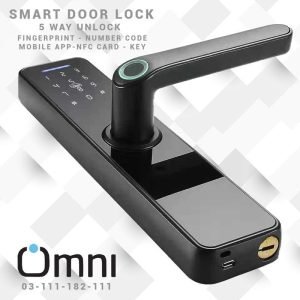What type of Electronic Smart door lock you should choose?
Are your hands full of grocery shopping and you are figuring out way to hold handle of lock?
Embarrassed because your guests had arrived unannounced and you are not home?
Well, it is time to upgrade to smart Wi-Fi door locks. You can get a Wi-Fi electronic smart door lock that provides you with the multiple options for configuration. It will not be right to say that remote door locks have made your home living heaven and secure. Electronic Smart door lock can be operated remotely which means that you can lock or unlock your doors from anywhere either you are home or at work, through your smart phone. You use finger to access or create temporary or permanent digital keys for your friends. Omni Smart Home Automation Solutions make the integration and installation affordable and easy for you with local warranty.
Do smart locks need Wi-Fi?
Different protocol options are available for integration of new smart home door locks, Bluetooth, ZigBee or Wi-Fi. Since it needs to be installed and able to communicate with the rest of your smart home setup so either it needs to be connected with centralized Hub or existing Wi-Fi router. Most of the smart locks are therefore connected through one of three common communication protocols: Bluetooth, ZigBee or Wi-Fi. Every protocol has its pros and cons. There are other less common and expensive options like Z-Wave.
Bluetooth Door Lock
Bluetooth is a common smart-lock protocol because it doesn’t burn through battery life as quickly. Bluetooth protocol has its own down side and that is the limitation of the range. It’s range is roughly 300 feet in a best-case scenario, and probably a lot less depending on how your home environment. It’s sufficient to control your electronic door lock while you are inside the house while what about when you are out? You’ll definitely lose the connection. Though no Central Hub is used if you want to connect through Bluetooth mode which makes it really convenient for your smart-home aspirations end at your smart lock, but hubs grant you the ability to control multiple connected devices from a single app, which can be more convenient than dividing home control among an assortment of device-specific apps.
ZigBee Door Lock
If you need to select the ZigBee protocol to connect to your electronic door lock, you might need a compatible hub. As Bluetooth connects directly with the lock, these locks need some configuration. That hub will translate the lock’s ZigBee signal into something your router can understand — once it does, you’ll be able to control it from anywhere.
It has more advantages than the disadvantages. As talking about the range of a ZigBee connection, it is about 120 feet, so the lock will need to be in range of hub. Though, additional ZigBee devices can act as range extenders by repeating the signal from the hub and sending it out further. The ZigBee signal can bounce up to four different times, for a maximum range of about 600 feet (walls, doors and other obstructions will all take a toll on range). Since Zigbee is IOt specific protocol therefore safety and options are unlimited.
Wi-Fi Smart Door lock
ZigBees have taken over the IOT but the biggest setback of ZigBee is the need of an additional hub. The plus side is that you can connect to more third-party devices than a standard Bluetooth lock if you have Smart Things or another multi-protocol hub. But, if you don’t plan to use your existing wifi router and a bunch of other devices with your Wi-Fi electronic door lock, ZigBee may not be right for you. Smart door locks with wifi are the best affordable option for quick upgrade without any hassle. Such locks come with multiple option to unlock which include finger sensor, remote app unlock, standard metal key, NFC card and numeric pass-code.




Add comment